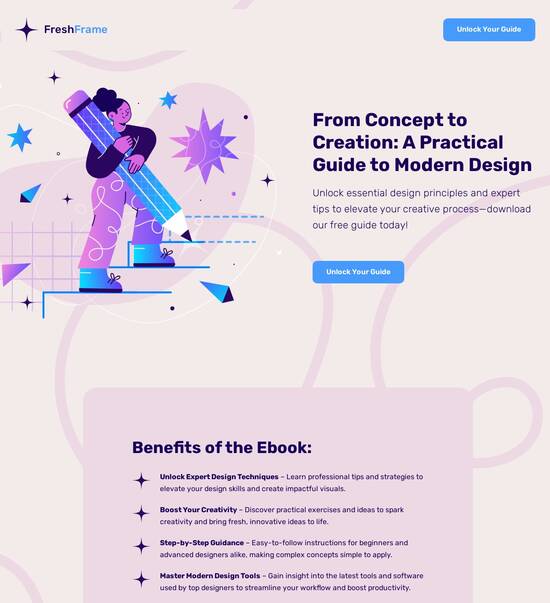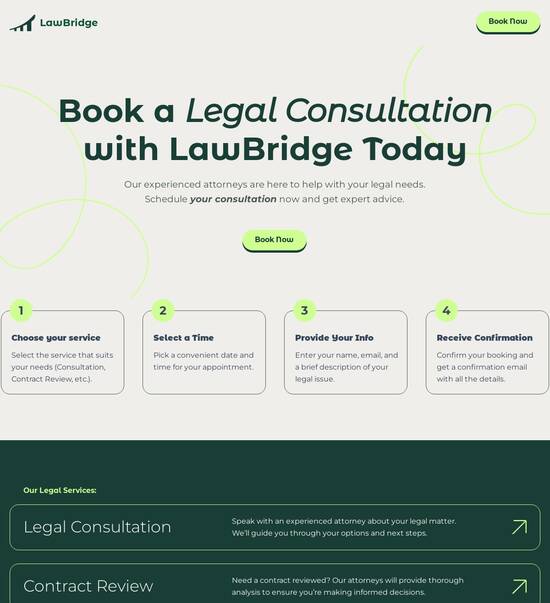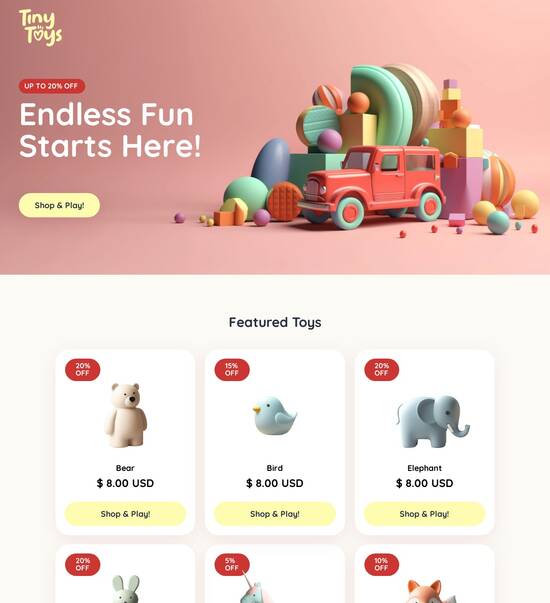
Basic environmental website template
Explore Similar TemplatesAbout template
Drive more leads with Instapage basic environmental website template built to maximize conversions. Easy customization - no designer or coding skills needed.
Recommended templates

Easy to build without coding
With the intuitive drag-and-drop builder, anyone on your team can create high-converting pages without any knowledge of code or design. Make enhancements to your landing page with custom widgets using Javascript, HTML/CSS, or third-party scripts.

Multiple layouts for any industry and goal
Select from 500+ landing page layouts built to boost conversions across industry-specific scenarios. Customize them by adjusting fonts, adding images, and generating on-brand content with the AI assistant. Quickly scale with Instablocks® and Global Blocks that you can save, reuse, and update globally.

Loads fast and looks polished on any device
Every template is responsive, which means they present professionally on any device and load blazingly fast with our Thor Render Engine. You can also power them up with Google AMP technology to deliver an unparalleled mobile experience and drive higher conversions.

Robust analytics & experimentation
Get real-time updates and reporting across all your devices, showing the number of visitors, conversions, cost-per-visitor, and cost-per-lead. Launch AI-powered experiments, run A/B tests, and use heatmaps to analyze user behavior, then optimize your landing page to maximize conversions.







Easy to build without coding
With the intuitive drag-and-drop builder, anyone on your team can create high-converting pages without any knowledge of code or design. Make enhancements to your landing page with custom widgets using Javascript, HTML/CSS, or third-party scripts.
Multiple layouts for any industry and goal
Select from 500+ landing page layouts built to boost conversions across industry-specific scenarios. Customize them by adjusting fonts, adding images, and generating on-brand content with the AI assistant. Quickly scale with Instablocks® and Global Blocks that you can save, reuse, and update globally.
Loads fast and looks polished on any device
Every template is responsive, which means they present professionally on any device and load blazingly fast with our Thor Render Engine.
Robust analytics & experimentation
Get real-time updates and reporting across all your devices, showing the number of visitors, conversions, cost-per-visitor, and cost-per-lead. Launch AI-powered experiments, run A/B tests, and use heatmaps to analyze user behavior, then optimize your landing page to maximize conversions.
All the features you need to build lead-generating landing pages
Explore more featuresLearn how to build top-performing landing pages for any goal
FAQs
Leading the way in building high-performing landing pages





A comprehensive guide to using Instapage for creating powerful landing pages
Instapage stands out as a leading platform for marketers seeking to enhance their online campaigns. With its suite of tools designed to optimize landing pages and conversion rates, users can tailor their marketing strategies effectively. This step-by-step guide will help you navigate the features and functionalities of Instapage, ensuring that you maximize the return on your digital marketing investments.
Understanding landing pages and their importance
Landing pages are crucial for any marketing campaign. They serve as the entry point for potential customers and play a significant role in converting traffic into leads or sales. Using Instapage, marketers can design landing pages that not only capture attention but also drive actions. Here are some key benefits of leveraging Instapage for creating landing pages:
- User-friendly design: Instapage offers intuitive drag-and-drop features that simplify the page-building process, allowing marketers of all skill levels to create stunning landing pages quickly.
- High-converting templates: With over 100 customizable templates, users can choose designs that align with their branding and campaign goals.
- A/B testing capabilities: Marketers can test different versions of a landing page to identify which elements drive better conversions, optimizing strategies based on data.
Step 1: Creating your landing page
To create a landing page using Instapage, start by selecting a template that matches your campaign goal. Customize the layout using the drag-and-drop editor to incorporate essential elements such as text, images, and forms.
Step 2: Optimize for conversions
Once your landing page is created, it's vital to optimize it for higher conversions. Consider incorporating the following elements:
- Clear call-to-action: Ensure your primary CTA stands out on the page, guiding visitors to take specific actions.
- Personalization: Use Instapage's dynamic text replacement feature to customize content based on the referring source, enhancing user engagement.
- Analytics integration: Track user behavior on your landing pages using heatmaps and analytics to gather insights for further optimization.
Step 3: Review and publish
Once you are satisfied with the design and optimization, review the landing page thoroughly. Utilize Instapage's collaboration features to gather feedback from your team, allowing for real-time edits before publication.
- Feedback loops: Encourage team members to provide input on the design and copy to ensure clarity and effectiveness.
- Security: Share your landing page securely with stakeholders to gather final approvals.
- Publishing: Instapage seamlessly integrates with various platforms, making it easy to publish your landing page directly to your domain.
By following these steps, you can leverage Instapage to create powerful landing pages that drive results. Start your journey towards higher conversions today and unlock the full potential of your marketing efforts.
Ready to elevate your marketing campaigns? Sign up for Instapage today and access a range of features designed to help you succeed in digital marketing!
Basic environmental website template: A guide to effective online presence
Understanding the importance of a basic environmental website template
Environmental websites play a pivotal role in advocating for sustainability and educating the public about pressing ecological issues. They serve as platforms where organizations can share knowledge, promote campaigns, and mobilize communities for a common cause. The urgent need for climate action and environmental stewardship makes these websites essential in fostering advocacy and awareness.
A basic environmental website template acts as a crucial foundation for these efforts. It provides a structured layout that can be easily customized while ensuring that essential features are in place. This allows organizations to focus on content rather than spending excessive time on design, enabling them to convey their messages more effectively.
Over the years, the landscape of environmental web presence has seen significant shifts. From 2007 to 2025, we can observe an evolution characterized by increased user engagement and interactive elements. Current trends suggest a greater emphasis on mobile accessibility and social media integration, with a future outlook pointing towards more innovative designs aimed at immersive user experiences.
Key features of an effective environmental website template
An effective environmental website template combines aesthetics with functionality, catering to diverse audiences. Here are some key features to consider:
Minimalist design for eco-friendly aesthetics: A clean layout and intuitive navigation help convey messages clearly while minimizing distraction.
Responsive layout for accessibility: A template must adapt to various devices, ensuring a seamless experience for all users.
HTML and CSS best practices: Structuring your code properly can improve SEO and enhance the site’s overall look.
Integrated sitemap for user navigation: A well-structured sitemap facilitates user navigation and boosts search engine visibility.
Content strategy for environmental websites
A clear content strategy is crucial for environmental websites; balancing text and imagery can maximize impact. Using authentic imagery that resonates with the topic helps tell a compelling story. Visuals should complement the written content, enhancing understanding and engagement.
Incorporating multimedia elements like videos and audio further enriches user experience. Interactive content, such as slideshow presentations or infographics, can draw users in and stimulate their interest in environmental issues.
It's essential to research appropriate keywords related to environmental topics. Optimizing content with meta tags and alt text is vital for visibility and accessibility. An efficient use of keywords ensures the website reaches its target audience effectively.
Contact forms should also be designed thoughtfully, balancing user interaction with privacy considerations. Implementing GDPR compliance helps to safeguard user information while fostering trust and transparency.
Enhancing user interaction on environmental websites
User interaction is key to maintaining engagement on environmental websites. Incorporating interactive features such as forums or comment sections encourages discussion and feedback, allowing users to share their insights and concerns easily.
Including social media sharing functionalities can amplify your message and extend reach beyond the website. This makes it easier for visitors to engage with and promote your content within their networks.
Building an email list through newsletter sign-ups is essential for ongoing communication. Engaging and informative newsletters can keep users informed about campaigns and encourage activism. Best practices for designing newsletters include ensuring clarity and providing relevant content that resonates with your audience.
Creating an events section or integrating campaign features is another way to promote awareness. Users can learn about workshops, clean-up efforts, or rallies, and integrate sign-up forms for these initiatives directly on the website.
Performance optimization for user retention
Site performance directly impacts user retention. Improving load speed through various techniques enhances user experience and keeps visitors engaged. Slow-loading websites can frustrate users, leading them to abandon the site before it loads.
Moreover, site performance contributes to the environmental footprint. Efficient coding and a streamlined user experience can lead to lower energy consumption for hosting solutions, aligning with sustainability efforts.
Implementing analytics and tracking user behavior is essential for continuous improvement. Metrics such as bounce rates, page views, and user sessions guide decisions about content and layout, ensuring the website meets user needs effectively.
Accessibility considerations must also be part of the design process. Ensuring that the website is usable by individuals with disabilities expands its reach, creating an inclusive environment for all users. Resource tools and testing methods can support this element of website development.
The future of environmental websites: Innovations on the horizon
Looking ahead to 2025 and beyond, it's crucial to consider what innovations might emerge in web design for environmental advocacy. Predictions indicate an increased use of AI and machine learning to personalize user experiences, making interactions more meaningful and tailored to specific audience needs.
Innovations in web technologies could further enhance sustainable hosting practices. Organizations may increasingly prioritize energy-efficient hosting services, contributing to eco-friendly online practices that align with their advocacy efforts.
Legal and ethical considerations in environmental website development
Understanding rights related to content usage is fundamental in environmental website development. This includes copyright and licensing issues relevant to images, text, and designs. Best practices involve attributing sources and ensuring content integrity to avoid legal challenges.
Transparency with users is equally critical. Having a privacy policy page informs visitors about their rights and data collection policies. Creating clear guidelines helps to maintain trust and encourages ongoing engagement with the site.
Finally, remaining informed about evolving environmental regulations that impact online presence is essential. Adapting to recent and anticipated regulations ensures compliance and fosters a responsible digital advocacy approach.
Ready to skyrocket conversions?
Supercharge your ad campaigns with high-performing landing pages
Get started














